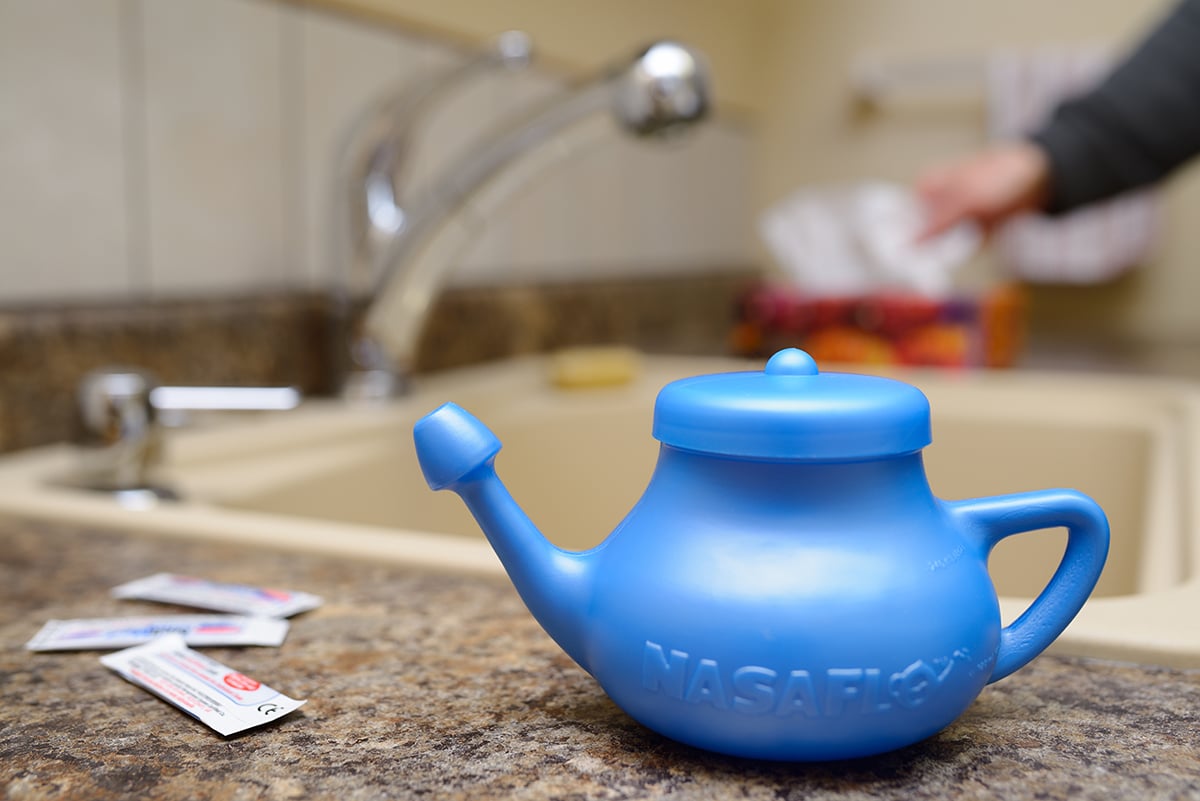With nearly 1 in 4 Americans coping with chronic nasal congestion, it’s no surprise that neti pots have become a common household staple. These quirky little vessels are more than a passing wellness trend – they’re part of an ancient technique of nasal irrigation that’s been used for thousands of years. And since being featured on Oprah in 2007, neti pots have soared in popularity as a natural remedy for sinus issues.
What is a neti pot?
A neti pot is a small ceramic or plastic device that looks like a cross between a gravy boat and a teapot. It’s used to push warm saltwater through one nostril and out the other, thinning mucus and flushing clogged nasal passages.
You need to go a little deeper to understand how neti pots work their magic. Your nasal and sinus cavities are lined with tiny, hairlike structures called cilia that push mucus toward the throat or toward the nose to be blown out. Saltwater helps speed up this process, helping cilia clear out irritants and allergens. It’s also gentler on nasal passages than plain water.
How effective are neti pots?
Neti pots are proven to reduce sinus congestion and inflammation caused by allergies, colds, flu, sinus infections and other upper respiratory conditions. The devices have been shown to:
- Clear mucus buildup
- Remove allergens like dust and pollen
- Improve breathing
- Ease sinus pain and pressure
- Flush out fine particles from wildfire smoke
- Moisten dry nasal passages
How do I use a neti pot?
While each neti pots comes with specific instructions, here’s a general guide to get you started:
- Prepare the saltwater: Fill the neti pot with a pre-packaged solution or make your own. If you opt to DIY, don’t leave it to guess work. The American Academy of Allergy Asthma & Immunology offers a simple recipe you can make at home. Always use iodide-free and preservative-free salt and warm distilled, sterile, or boiled (then cooled) water.
- Position yourself: Lean over a sink and tilt your head at about a 45-degree angle to keep the liquid from going in your mouth.
- Breathe through your mouth: Place the neti spout into your top nostril and gently pour the solution in.
- Let it flow. The saltwater will travel through your nasal cavity and exit the other nostril. Spit out any liquid that runs into your throat.
- Blow your nose: Clear out any remaining fluid.
- Repeat: Refill the pot and repeat on the other side.
It might feel strange at first, but most people get used to it with a little practice. Some mild, temporary side effects may include:
- Burning or stinging
- Nasal irritation
- Dryness or nosebleeds (especially with overuse)
Are neti pots safe to use?
Neti pots are safe when used correctly, but improper use can lead to serious infections. According to the Centers for Disease Control and Prevention (CDC), using tap water for nasal irrigation can expose you to dangerous microorganisms, including a rare but deadly brain-eating amoeba that is found naturally in soil and many types of water, including lakes, rivers, and tap water. A 2021 study found that 62 percent of adults mistakenly thought tap water was safe for nasal rinsing.
To use your neti pot safely, follow these important steps:
- Use the right water: Always use distilled or sterile water. Tap water is only safe for rinsing your nasal passages if you boil it for at least a full minute and then cool it to room temperature.
- Follow the instructions: Carefully read and follow the instructions included with your neti pot to make sure it’s right for your symptoms and to ensure proper use.
- Keep it personal: Never share your neti pot, as it can transmit bacteria, viruses, and other pathogens.
- Clean thoroughly: Wash your neti pot by hand with soap and water after every use. Dry with a paper towel or air dry completely before using it again.
How often should I use my neti pot?
Start slow, especially if you’re new to nasal irrigation. Begin with one session per day and increase gradually if needed. For chronic sinus issues, twice a day may be recommended while milder symptoms may only require occasional use. Overuse can irritate your nasal passages, so be mindful. If you’re unsure, consult a health care provider for personalized advice based on your symptoms.
Do not use a neti pot if you don’t have symptoms. It won’t prevent nasal issues and could lead to infection. “Good” mucus is necessary to help trap germs and irritants and kill some bacteria.
When should you not use a neti pot?
Neti pots aren’t for everyone. Avoid nasal irrigation if you:
- Have an ear infection or pressure in one or both ears
- Have a completely blocked nostril
- Recently had ear or sinus surgery
For those with weakened immune systems, consult a health care provider before using a neti pot.
Are neti pots appropriate for kids?
Most medical experts – and the Federal Drug Administration (FDA) – agree that children older than 2 can use a neti pot with the approval of a health care provider. While generally not recommended for children under the age of 2, neti pots may be suitable for little ones diagnosed with nasal allergies.
If you do get the green flag from a health care provider, be sure to use a child-size version of the device.
Indigo is here when you need relief
Neti pots are a great tool for relieving nasal congestion, but they only address the symptoms – not the underlying cause. If you’re dealing with ongoing sinus issues, Indigo Urgent Care is here to help you breathe easier.
For in-person care, walk into one of our convenient locations or book an appointment online. Or skip the trip to the clinic and schedule a face-to-face virtual appointment from anywhere.
Either way, one of our friendly clinicians will assess your symptoms, provide a prompt diagnosis, offer treatment recommendations, and provide a prescription, if needed. They’ll also answer any questions you have about using a neti pot.
If you experience any of the following symptoms after using a neti pot, call 911 or visit your nearest emergency department:
- Severe headache
- High fever (over 101.4 degrees)
- Confusion
- Vomiting
- Difficulty breathing


